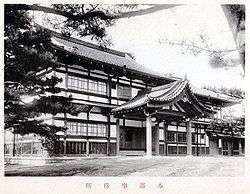Dai Nippon Butoku Kai
 | |
| Founded | 1895 April 17th |
|---|---|
| Dissolved | 1946 November 9th |
| Type | Sports organization |
| Headquarters | Kyoto, Japan |
Membership | Unknown. |
Official language | English and Japanese |
President | Mr. H. T. Hamada |
| Website |
Dai Nippon Butoku Kai http://www.dnbk.org/ |
Dai Nippon Butoku Kai (DNBK) 大日本武徳会 (lit. "Greater Japan Martial Virtue Society") is a Japanese martial arts organization established in 1895 in Kyoto.[1] DNBK states that its aims include the restoration of classical martial cultures and promotion of international peace and harmony through the education and training of the traditional martial arts disciplines.[1] Though the Dai Nippon Butoku Kai voluntarily disbanded after the end of the Second World War but the request was not accepted by the new government. In 1946 November 9th, the original DNBK was officially disbanded by the order of GHQ of SCAP. A new DNBK was re-established with a new philosophy in 1953.[2]
History
The Establishment of the Organization
Dai Nippon Butoku Kai (DNBK) was established in 1895 under the authority of the Ministry of Education and sanction of the Emperor Meiji.[3] Its purpose, at that time, was to standardize martial disciplines and systems throughout Japan.[4] This was the first official martial arts organization sanctioned by the government of Japan. It promoted the martial virtues of samurai warriors and high historical proficiency in martial disciplines.[1]
During a time when foreign influence was viewed as a threat to Japanese identity, the DNBK was formed chiefly to perpetuate Japanese cultural traditions such as bugei and bushido.[5] To facilitate the continuation of these traditions, the Meiji Government permitted the group to perform the following:[6]
- Hold exhibitions and tournaments,
- collect weapons and equipment,
- maintain documents detailing classical combative arts, and
- publish martial-arts related material
After the end of World War II, the Supreme Commander of Allied Powers (General Douglas MacArthur) issued a directive to dissolve all military-related organizations, and in response the Dai Nippon Butoku Kai (DNBK) voluntarily disbanded on October 31, 1946.
The Reestablishment of the Organization
In 1953, a new DNBK was reestablished, and officially formed in 1957 with a new charter and a new philosophical vision.[7] The new purposes of DNBK stresses preservation of classical martial arts tradition and emphasizes upon restoring the heritage, and virtues of martial culture and the promotion of education and community service through martial arts training.[7]
The first official division outside Japan was established in Virginia (USA) and in 1985 a division in the east coast USA.[7] In 1992, DNBK officially established the International Division under the leadership of Tesshin Hamada overseeing all international members.[7] In 2011, DNBK has official representatives and coordinators in Canada, United Kingdom, Italy, Belgium, Portugal, Israel, Hungary, Russia, Germany, Spain, Malta, France and California USA, Hawaii USA, Mid-Western USA, Boston USA, Arizona USA, Florida USA, Australia, Romania, Switzerland, Armenia, Chile, Switzerland, Greece, Gibraltar, Austria, and Nepal.[7] In 2012, after 60 years of DNBK operation since 1952, it became once again the General Corporation sanctioned by the Japanese National Government.
Martial disciplines
Disciplines which are officially approved and recognized by the Dai Nippon Butoku Kai (DNBK) includes the following:[7]
Legitimacy
Honbu Dai Nippon Butoku Kai (DNBK) authorizes and certifies martial arts credentials.[1] In 2011 DNBK has registered nearly two thousand Yudansha in 35 nations.[1]
Ranking System
The Dai Nippon Butoku Kai (DNBK) use the shōgō system where the levels in order of increasing prestige are renshi (錬士), kyōshi (教士), and hanshi (範士).[8]
Representatives
Kendo
Among the listed representatives of the DNBK International Division is Kim Baylor who is Renshi in Kendo.[9] Further are Manabu Adachi, Hanshi, 9th Dan Kendo, and Masakatsu Tsujino, Hanshi, 9th Dan Kendo advising counsellor of the board.[10]
Some of the historical highlights concerning kendo are following:[7]
- 1895: The Dai Nippon Butoku Kai (DNBK) was established in Kyoto, Japan.
- 1942: DNBK controlled All Japan Kendo Federation and promoted kendo.
- 1998: The official participants demonstrated the discipline of kendo.
- 2011: Kyoto Elite Budo Seminar for Kendo was also conducted.
External links
References
- 1 2 3 4 5 Dai Nippon Butoku Kai: Honbu, Kyoto, Japan (2012). Retrieved on July 8, 2012.
- ↑ 大日本武徳会 - Mixi Community (2015). Retrieved on December 1, 2015
- ↑ McCarthy, Patrick; McCarthy, Yuriko (1999). Ancient Okinawan Martial Arts. Boston, MA: Tuttle Publishing. p. 73. ISBN 978-0-8048-2093-6. Retrieved 24 July 2012.
Founded during the Meiji Period...the Dai Nippon Butoku-kai was set up in the ancient capital of Kyoto in 1895.
- ↑ All Japan Kendo Federation (February 1, 2000): Japanese-English Dictionary of Kendo (p. 46). Tokyo.
- ↑ McCarthy & McCarthy 1999, p. 73
- ↑ McCarthy & McCarthy 1999, p. 74
- 1 2 3 4 5 6 7 Dai Nippon Butoku Kai: History and philosophy (2012). Retrieved on June 8, 2012.
- ↑ Wanda Hurren, Erika Hasebe-Ludt (ed) (2014) Contemplating Curriculum: Genealogies/Times/Places. Routledge. Page 5. ISBN 978-0-415-64058-9
- ↑ Dai Nippon Butoku Kai: International Representatives
- ↑ Dai Nippon Butoku Kai: Hombu Officials